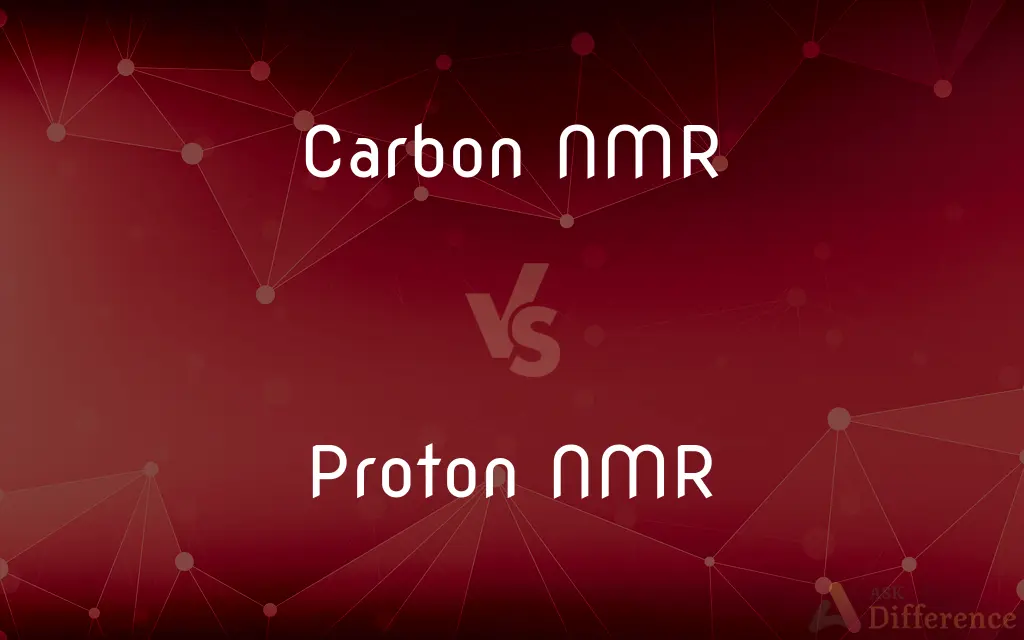Carbon NMR vs. Proton NMR — What's the Difference?
By Tayyaba Rehman — Published on November 14, 2023
Both are nuclear magnetic resonance spectroscopy techniques, utilizing carbon-13 and proton (hydrogen) nuclei, respectively. Carbon NMR provides detailed carbon skeleton information, and Proton NMR understands molecule hydrogen environments.

Difference Between Carbon NMR and Proton NMR
Table of Contents
ADVERTISEMENT
Key Differences
Carbon NMR (Nuclear Magnetic Resonance) spectroscopy revolves around the interaction of carbon-13 nuclei with an external magnetic field, offering intricate details regarding the carbon skeleton of organic compounds. In contrast, Proton NMR similarly explores the behavior of hydrogen nuclei in a magnetic field, emphasizing their diverse environments, and presenting crucial insights about molecular structure and hydrogen positioning in compounds.
In the context of Carbon NMR, the isotope 13C is studied due to its +1/2 and -1/2 nuclear spin states, thereby making it NMR active and invaluable in probing the carbon atoms within organic and inorganic materials. Proton NMR, on the other hand, centers its investigation around 1H nuclei, exploiting their ubiquitous presence in organic structures and thereby commonly serving as an initial investigative tool in molecular identification and conformational analysis.
The application of Carbon NMR generally provides clear insights into the skeleton of organic molecules, allowing scientists to decipher the arrangement of carbon atoms and identify different carbon environments present within the structure. Contrarily, Proton NMR, while also explicating structural details, especially focuses on understanding the environment and arrangement of hydrogen atoms, revealing data about the number of proton neighbors, their coupling constants, and chemical shifts.
Carbon NMR typically exhibits less sensitivity compared to Proton NMR due to the lower natural abundance of 13C isotopes and weaker gyromagnetic ratio. Whereas Proton NMR often displays pronounced sensitivity and consequently sharper peaks due to the higher natural abundance of 1H isotopes and a stronger gyromagnetic ratio, rendering it generally more utilized for detailed spectral analysis in various fields.
Carbon NMR, whilst being a powerful tool for understanding carbon skeleton structures, often requires higher concentrations of samples for optimal visibility and may implement techniques like DEPT (Distortionless Enhancement by Polarization Transfer) for enhancing spectral information. Proton NMR, being intrinsically more sensitive and detailed, often serves as a primary method in elucidating molecular structures, establishing itself as a fundamental technique in organic chemistry and biochemistry research endeavors.
ADVERTISEMENT
Comparison Chart
Target Nucleus
Carbon-13 (13C)
Proton (1H)
Sensitivity
Lower due to reduced abundance of 13C
Higher due to abundant 1H
Common Applications
Carbon skeleton identification
Hydrogen environment analysis
Typical Chemical Shifts
Wider range, 0-220 ppm
Narrower range, 0-12 ppm
Auxiliary Techniques
DEPT for identifying C types
COSY, NOESY for complex structures
Compare with Definitions
Carbon NMR
Sensitive to the electronic environments of carbon atoms.
Carbon NMR successfully elucidated the carbon skeleton of the novel compound.
Proton NMR
Centers around the interaction of proton nuclei with magnetic fields.
Proton NMR revealed information about the hydrogen bonding within the molecule.
Carbon NMR
Utilizes the NMR-active 13C isotope.
To enhance the spectrum, Carbon NMR was performed on a sample enriched with 13C isotopes.
Proton NMR
Widely utilized in elucidating molecular structures.
Scientists used Proton NMR to understand the complex structure of the natural product.
Carbon NMR
May employ DEPT to differentiate carbon types.
DEPT Carbon NMR helped in distinguishing between quaternary and CH carbons.
Proton NMR
Delves into the chemical environment of hydrogen atoms.
Proton NMR assisted in deciphering the number of proton neighbors in the compound.
Carbon NMR
Investigates environments of carbon-13 nuclei.
The Carbon NMR spectrum displayed varied chemical shifts revealing different carbon environments.
Proton NMR
Essential for understanding proton coupling.
Through Proton NMR, the J-coupling constants were accurately determined.
Carbon NMR
Commonly used to discern the carbon skeleton of organic molecules.
Carbon NMR provided crucial details about the backbone of the synthetic polymer.
Proton NMR
Commonly provides detailed splitting patterns.
The splitting pattern in the Proton NMR spectrum indicated the adjacent hydrogen atoms.
Common Curiosities
Why is Proton NMR more sensitive than Carbon NMR?
Proton NMR is more sensitive due to the higher natural abundance and greater gyromagnetic ratio of 1H.
Why are coupling patterns crucial in Proton NMR?
Coupling patterns in Proton NMR reveal how protons interact, providing insights into molecular structure.
Does Carbon NMR require isotopic enrichment?
It’s not always required, but isotopic enrichment of 13C can enhance sensitivity in Carbon NMR.
Can Carbon NMR differentiate between carbon types?
Yes, using techniques like DEPT, Carbon NMR can differentiate between carbon types.
What key information is derived from Proton NMR?
Proton NMR provides key data on hydrogen environments, coupling, and number of neighboring protons.
Can Carbon NMR determine hybridization states?
Yes, Carbon NMR can help determine carbon hybridization states through observed chemical shifts.
Is Carbon NMR applicable for inorganic compounds?
Yes, Carbon NMR can also be applied to study certain inorganic compounds containing 13C.
What auxiliary techniques might be used with Proton NMR?
Techniques like COSY and NOESY might be used alongside Proton NMR for elucidating complex structures.
What makes 13C relevant for Carbon NMR?
13C is relevant for Carbon NMR due to its nuclear spin (+1/2, -1/2), making it responsive to NMR.
Can Carbon NMR and Proton NMR be used together?
Yes, utilizing both can provide comprehensive structural information about the molecule under study.
What is the range of chemical shifts in Proton NMR?
In Proton NMR, chemical shifts typically fall within a range of 0-12 ppm.
Can both Carbon NMR and Proton NMR be performed on the same sample?
Yes, both Carbon NMR and Proton NMR can be performed on the same sample for comprehensive analysis.
Why is Carbon NMR crucial in organic chemistry?
Carbon NMR is crucial for revealing detailed information about the carbon skeleton in organic molecules.
Can Proton NMR elucidate stereochemistry?
Yes, Proton NMR can provide insights into stereochemistry through coupling constants and chemical shifts.
How are chemical shifts calibrated in Proton NMR?
In Proton NMR, chemical shifts are often calibrated using TMS (tetramethylsilane) as a reference.
Share Your Discovery

Previous Comparison
Granulated Sugar vs. Regular Sugar
Next Comparison
Inflectional Morphology vs. Derivational MorphologyAuthor Spotlight
Written by
Tayyaba RehmanTayyaba Rehman is a distinguished writer, currently serving as a primary contributor to askdifference.com. As a researcher in semantics and etymology, Tayyaba's passion for the complexity of languages and their distinctions has found a perfect home on the platform. Tayyaba delves into the intricacies of language, distinguishing between commonly confused words and phrases, thereby providing clarity for readers worldwide.












































